Ericsson field telephone M3926-384011
Translated with notes by Had Robinson
updated October 6, 2021
These are some of the toughest and most reliable field telephone sets ever made. The components were made to last forever, including the leather parts, and the rubber diaphragm on the case top. The original telephone set came with the following accessories: a.) dialer b.) handset c.) extra earphone d.) hand tool e.) instructions (in Swedish). On the surplus market all or none of these accessories may be present with the set. It can be used to a private network consisting of other similar compatible telephone sets or to a public telephone network.
During inclement weather, the set can be used in LB mode by replacing the cover and dressing the cables through the small openings beneath the latches.
On the inside of the cover is a wiring schematic of the set which could be useful for repairs, as needed.
Ericsson's review (1935 English) of this set has extensive information on its features and how it should be used, especially during wartime.
Ericsson field telephone M3926-384011 original instructions in Swedish
A. Setup
Plug the handset connector (#1) to the telephone as shown. The extra earphone connector (#2) may be connected as shown. The extra earphone permits a third party to monitor the telephone conversation.
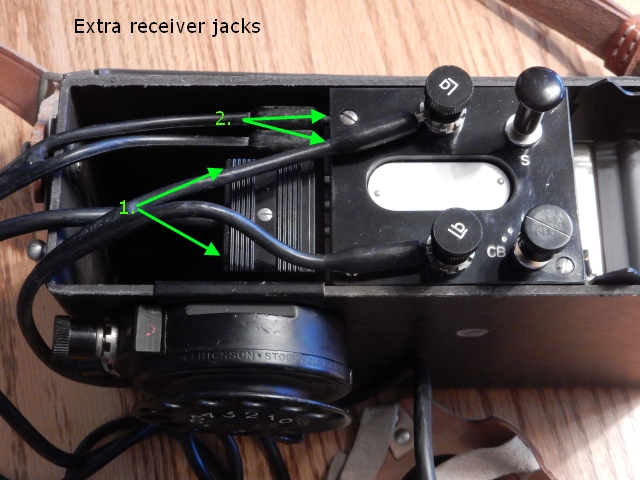
B. Batteries
The set requires (2) "D" sized batteries. See the diagram below for correct battery placement (Bild 2). The battery holder is held firmly in place by a metal plate with a knurled screw. It must be removed in order to remove the battery holder. The batteries supply a small voltage that is necessary for the microphone to function. You cannot be heard by others if you do not install the batteries! The set is not polarized so it does not matter which way the battery holder is installed. If it is placed with the diagram on it facing out, it is easier to see if the battery holder is installed or not. The use of lithium batteries is recommended as they will last for many years, not leak, and may be permanently left in the set. All other types of batteries will slowly discharge and ooze chemicals that can ruin the battery holder.
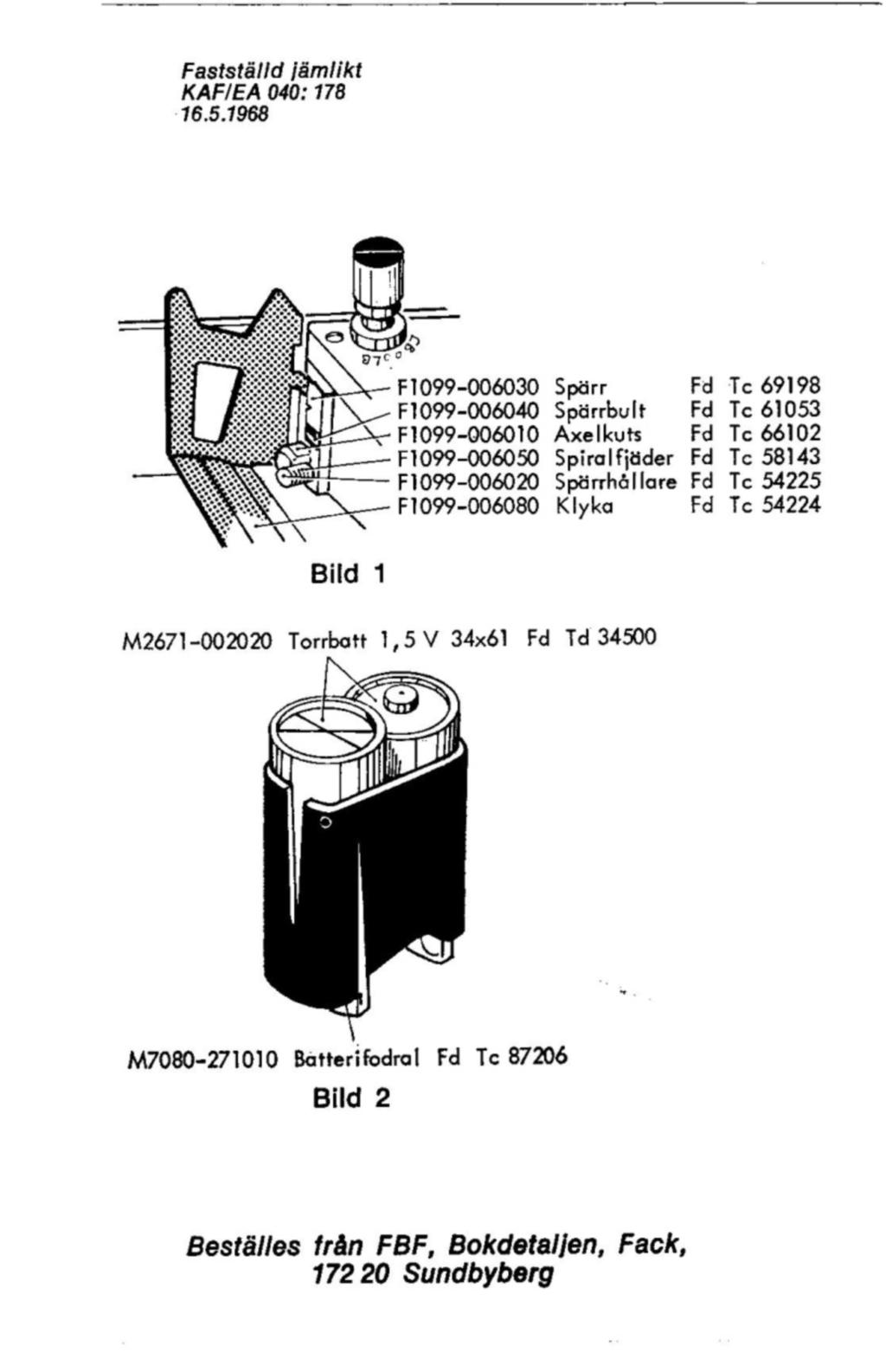
Parts identification (Bild 1) and battery holder details (Bild 2)
C. Network selection
This telephone set can be connected directly to other compatible sets over a common twisted pair of wires (LB mode). Such an ad hoc network can extend for miles with an any number of sets connected together. The only limited factor is that with too many sets, the ringers on the sets may not ring loud enough to be heard. Alternately, this set can be connected to a public non-digital telephone network. These networks are still common around the world including most wired networks in the U.S.A.
In any case, this Ericsson field telephone must have the selector knob set correctly *before* connecting it to other compatible field telephones or to a telephone network. Setting the selector is not simple. Do NOT force the knob! See the instructors below on how to set it. The white notch on the top of the selector knob points to either of the white dots that are adjacent to CB or LB, respectively. Note: the LB letters are not visible in the photo below. Do *not* hold the handset to the ear when making any changes with the selector knob as the DC impulses (clicks) are very loud!
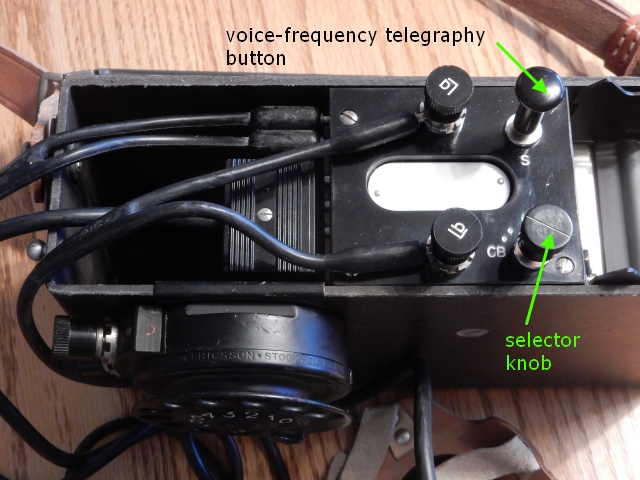
LB – Field telephone operation (not connected to a central station network)
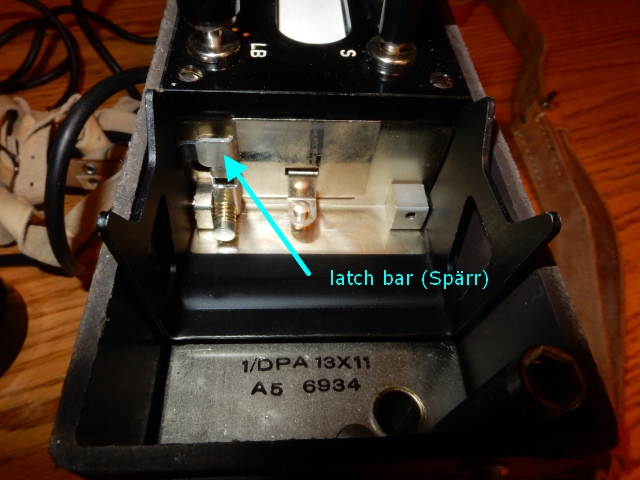
- Selector knob must be in the LB position. If it is in the CB position, do the following: Pull the latch bar (Spärr) straight out 1/2" (12mm) and hold it. Press down the selector knob and turn to position LB. Let the latch bar (Spärr) spring back. It will lock the selector in the LB position.
- Making a Call Ring the other field telephone(s) on the network by turning the hand crank briskly. It is easy to send codes via the ringer e.g. one long, two short rings so that a user can know if the call is for him.
- Handset button (located on the handset) must be depressed when speaking in order for the other party to hear. It may be released when listening or held for the entire call (the handset will then behave like an ordinary telephone handset). When the button is released, the microphone is disconnected so that other telephone sets cannot hear anything.
- Receiving a Call Wait until the ring signal stops and *then* lift the handset to the ear to avoid injury by the very loud ring signal.
- Ending a Call You may return the handset to the holder though it is not necessary in LB mode. It can be simply laid down on the ground or a table. In this mode the telephone set is always connected to all other sets on the network. That is, at all times any conversations between other telephone sets can be heard by all connected telephone sets.
CB – Central station telephone network operation (a public telephone network)
When in CB mode place the handset in the holder when the telephone is not in use. In doing this you will know that the selector knob is in the correct position (up) to receive a call. Do not use the hand crank when in CB mode.
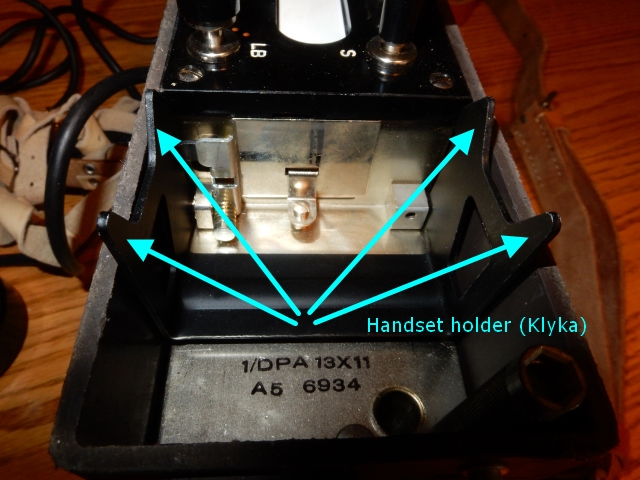
When used on a central station network, connect the dialer to terminals La and Lb and the wires from the central station to the two terminals on the dialer. The set is not polarized so it does not matter which wire from the central station goes to the connectors on the dialer.
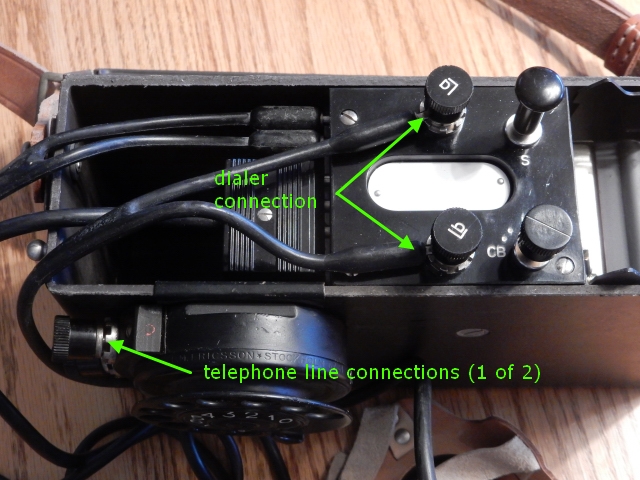
- Selector knob must be in the CB position. If it is in the LB position, do the following: Pull the latch bar (Spärr) straight out 1/2" (12mm) and hold it. Turn the selector knob to position CB. Let the latch bar spring back and lock the selector knob in position.
- Making a Call Remove handset, press the selector knob down, and check for dial tone. Use dialer as needed. The dialer numbers are in the Swedish manner. If used on a U.S.A. public network, you will have to shift the number scheme clockwise once i.e. move "1" to "0". "0" is now where "9" used to be.
- Handset button must be depressed when speaking in order for the other party to hear. It can be released when listening or held for the entire call.
- Receiving a Call When the ringer is heard, lift the handset from the holder and press the selector knob to its lower (locked) position.
- Ending a Call Return the handset to the holder. The selector knob will pop up to its upper position.
- Hand crank Do *not* use the hand crank at any time when the telephone is connected to a central station network. The central station, not the telephone originating the call, supplies the ring signal to the other telephone.
D. Connecting to a network
Once the network type is selected, the telephone may then be connected to either the public central station network or directly to other field telephones via terminals La and Lb. It does not matter which terminal is used to connect to a network as the set is not polarized. Note: these telephones will not work connected to digital networks e.g. private networks in office buildings, hospitals, etc.
E. Miscellaneous
The knob labeled “S” is used for voice-frequency telegraphy in the same manner as a telegraph key. As Ericsson notes in its review of the set, the presence of the set's tone generator allows the user to employ voice-frequency telegraphy when speech is unintelligible or background noise is excessive. The knob can be actuated through the lid, as necessary, via the black rubber diaphragm.

The set has a small tool stowed near the hand crank which can be used to disassemble the telephone (remove it from the case). One end has a socket which, presumably, is for use on Swedish telephone block terminals. I do not recommend using the tool to undo the (3) exterior screws that hold the set in its case because the screws slots are much larger than the tool's blade. If the screws are not tightened firmly, they can loosen. We discovered this hauling these telephones through deep caves.
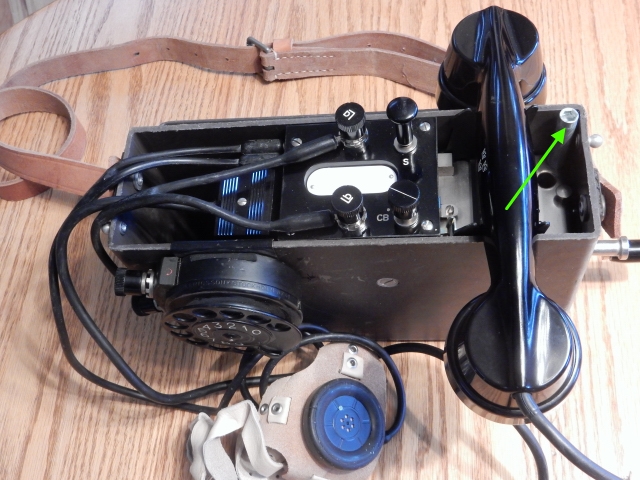
F. Maintenance
Do not use anything but soap and water to clean any part of the set. Light non-detergent SAE 30 oil may be used as needed on the hand cranked alternator bearings. Bearing grease can be applied to the gears, as needed. Remember to remove the batteries when not in use to prevent corrosion (unless they are lithium).
![]()




